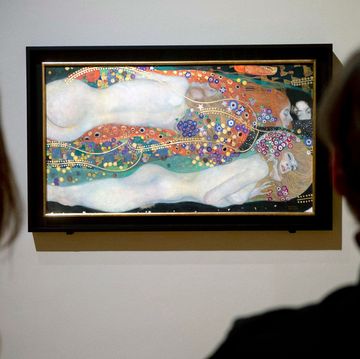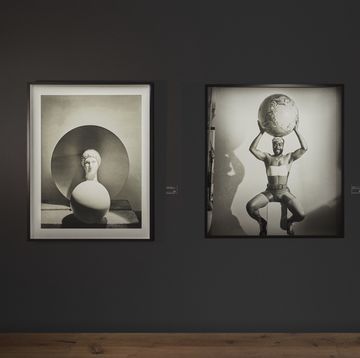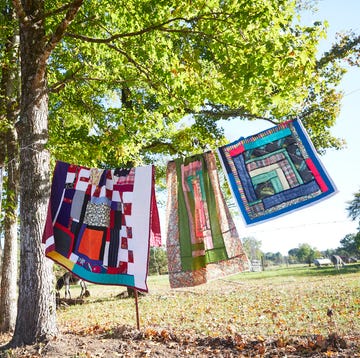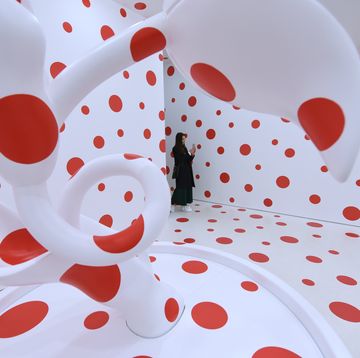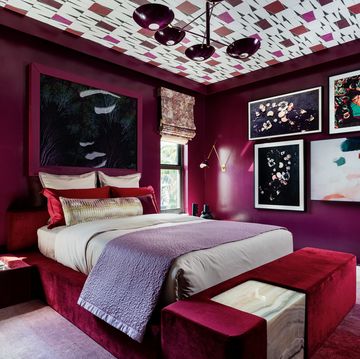An art
Lauren Sands, founder of the new digital art collecting platform LES Collection, was just 13 years old when she selected the first piece of art for her bedroom and a passion for collecting was born. Growing up in a family that adored the arts, it was natural for Sands to spend hours at Artisan Works, a family-favorite nonprofit gallery in Upstate New York, searching through the archives that boast hundreds of thousands of pieces and learning about different artists, mediums, and movements. She also married an avid art collector and the couple loves to spend their travels and weekends perusing art fairs, galleries, and markets for the next great find.
However, Sands realizes that most people didn't grow up with such exposure to the art world, and she began thinking about ways to make art more accessible to all while offering her business and legal skills to artists. The pandemic led her to a major career pivot (she was formerly a lawyer) in building a digital platform that provides education and empowerment to consumers, offers support and exposure to a broader audience for artists, and, ultimately, creates a place for both to connect and build the kind of relationships she has with her favorite creatives.
More From Veranda

We chatted with Sands, along with Chelsea Neman Nassib of the widely acclaimed Tappan Collective, a digital art gallery and education platform that helped revolutionize the way we shop for art since its founding in 2012, to learn more about how to become an art collector without getting overwhelmed.
What to Consider Before Starting An Art Collection
Both Sands and Neman Nassib offer resounding encouragement for anyone who is interested in in art collecting. So long as you're purchasing with thought and intention—and willing and able to dedicate time to learning more about artists and their work, Sands says anyone can start collecting art regardless of budget constraints or level of education or expertise.
"Collecting is for everyone, and you should just go for it," says Neman Nassib. "That's one of the things we are so bullish on and passionate about. We really wanted to reinvent the approach to discovering contemporary art work and help people learn why they are drawn to things. We are trying to do this on our platforms so that people feel more comfortable purchasing artwork and so that we can hopefully break down the barriers of intimidation."
Both the collectors' main advice is to collect to add value to your life and personality to your home, not as a means of filling wall space in your home. They encourage being patient and taking your time with this journey, allowing yourself to explore and discover the different makers and movements that inspire and speak to you.
How to Start Collecting Art
Neman Nassib advises those who want to start collecting to get out there, see as much as possible, and look for beautiful pieces that mean something to you.
"Trust yourself and see what you are drawn to and learn what you like," she says. "It's the same with anything else: fashion, home decor, wine, or music. Everybody has their own unique taste and needs to honor that. The more you can understand what you like, the more you can discover about artists and their practices. From there, your taste will develop and that will happen naturally over time. That's the beauty of the journey."
Sands says it's really important to begin that exploration phase straight away and be unafraid to buy a piece that speaks to you—even if you have no idea where it will find a place in your home. However, she says the key to successful art collecting and investing wisely is to remember it is a process and that building a true collection takes a lifetime.
"Follow galleries that have an aesthetic you love and follow the artists themselves because they are constantly sharing other artists’ work and will help you continue to find other art that speaks to you,” says Sands. "I also think people generally believe commissions are out of their budget and only for the uber-wealthy but they're not. If you find an artist you really like, talk to them about creating something custom for you. Most artists would be excited to do that because they love to make that kind of connection with their collectors."
Sands also advises finding art through vacations, art fairs and markets, auction houses, and via Instagram, while Neman Nassib says to make sure any literature that is offered at the location or event where a piece was purchased should be saved to preserve the value and provenance of the work. Shopping through a gallery like LES Collection or Tappan Collective also helps to make sure you’re getting a fair price on a piece and that it’s an original. LES Collection also offers art consultation and commissions for those who are looking for collecting assistance, education, or just a more budget-friendly way to display their love for a new favorite creative. Besides being an e-commerce platform for art shopping, Tappan Collective also offers personal curatorial services and project management for corporate clients and developers looking to bring art into their commercial spaces. Sands says just as commissions aren’t just for high net-worth individuals, neither is an art consultant—and there are plenty of experts out there willing to work with any budget.
Displaying Your Art
You thought buying a piece of art was overwhelming, but now how to display it? Just like with collecting, Sands and Neman Nassib say that finding the right frame and place to display the piece doesn't have to be a stressful experience.
"In general, there’s no right way to have artwork exist in your space," Neman Nassib says. "I think, similar to collecting and styling, it's all an expression of who you are, and the less fearful we can all be around how to interact with the artwork, the better off we are."
Both collectors stress the importance of using the right glass to preserve your piece in order to protect against UV rays. Museum quality glass is expensive but worth it, especially if your home or the room you want to display a work in is full of natural light. Sands says there are some great non-museum quality glass options out there that may give off a slight glare depending on the light in a space, but it's a smart option for darker rooms. Deciding how to display art is also a great problem for your favorite designer to solve, and most will be willing to help you find the right framing options and the best plan for displaying your pieces proudly.
Common Art Collecting Mistakes
"The biggest mistake you can make is buying mass-produced work because you don't want to live with an empty wall," says Sands. "Not only is this a less sustainable way to live if you know you're going to throw out the piece eventually, but also there's no real connection to the work. I think it's much better to take your time, go slowly, and live with some empty walls for a bit."
Neman Nassib says a common saying in the art world is to "buy with your eyes, not your ears." Just like in fashion or interior design, purchasing a piece of art simply because it's trendy and hot in the moment, not because it resonates and speaks to you, robs you of the joys of collecting. She says just because the sepia photo of a horse is convenient to purchase at a big-box retailer, doesn’t mean you should sacrifice your personal style and taste. The thrill of the hunt is one of the best parts of being a collector.
"I think art is an expression of who you are, and it’s a beautiful thing to collect over time because looking back at your collection is like looking back at a time capsule,” says Neman Nassib. “Every piece you collect along the way reminds you of a time in your life, and the more unique you can with your collection, the more representative it is of who you are."
Lauren Wicks is a Birmingham-based writer covering design trends, must-have products, travel inspiration, and entertaining. She’s obsessed with globally inspired textiles, hosting dinner parties, and French cocktails.








